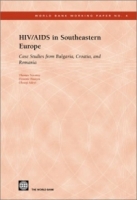| HIV/AIDS in Southeastern Europe: Case Studies from Bulgaria, Croatia, and Romania (World Bank Working Paper, No 4) (World Bank Working Papers) артикул 529e. |
 |
Book DescriptionA World Bank Working Paper # 4 The Countries of Southeastern Europe (Bulgaria, Croatia, and Romania) have re-committed themselves to scale up action on the prevention and treatment of HIV/AIDS in the sub-region These three countriesshare several social conditions that have led to an alarming increase in HIV infection These озтто conditions include increasing unemployment and poverty, rapid social changes, a decrease in the accessibility and quality of services and educational opportunities, psychological stress from post-conflict situations, increased substance abuse and sex work, and increased trafficking in women for sexual exploitation This paper reviews the current status of the AIDS epidemics in the three countries, evaluates the approaches and strategies currently being used in each country, and makes recommendation both for government strategies and for the World Banks current and potential future involvement in relation to these strategies Potential interventions areorganized according to four general groupings: Epidemiology and Operational Research Health Care and Social Services Health Communications and Promotion Civil Society and AdvocacyDownload DescriptionThe purpose of this paper is to review the current status of the AIDS epidemics in Bulgaria, Croatia, and Romania, to evaluate the approaches and strategies currently being used in each country, and to make recommendations both for government strategies and for the Bank's current and potentialfuture involvement in relation to these strategies The paper is divided into three sections: 1) an overview of recent regional perspectives; 2) a situation analysis and evaluation for each country including current strategies and implementation arrangements, and 3) a discussion of potential actions by the Bank The following approaches were used to complete the study: (i) Collecting data and documents on the current state of the AIDS epidemic in the ECC05 countries (Bulgaria, Croatia and Romania) Information was obtained from UNAIDS, national AIDS committees and commissions (including UN Thematic Groups), and reviews of published literature This report draws heavily on information produced in conjunction with Rapid Assessment Reports and the June6-8, 2002, conference on HIV/AIDS in Southeastern Europe, held in Bucharest, Romania (ii) Reviewing each of the various government and UN-related strategies that are already in place to deal with the epidemics in terms of both prevention and treatment (iii) Assessing which national and international organizations (Non-governmental Organizations [NGOs], UN Organizations, European Union, etc ) are involved in which aspects of prevention, treatment, or advocacy related to HIV/AIDS, and the extent to whichthese activities are integrated into the national government strategies (iv) Visiting each of the countries twice to interview key informants, People With AIDS (PWAs), target group members, government officials, and UN agency field staff (April-June, 2002) (v) Highlighting those components and activities of current or previous World Bank projects related to HIV/AIDS and the relationship of this activity to the government strategies and unmet needs (vi) A peer review by individuals with particular knowledge of HIV/AIDS prevention and treatment programs from within the World Bank, the medical community, the donor community, NGOs, and country counterparts This study does not aim to duplicate any research, data collection, or analyses already completed, but rather to inventory information and to assess what pieces may be missing from current and future planning activities Future directions as to where the World Bank may provide added value in the control of the nascent epidemics of HIV/AIDS in these countries are discussed. Размеры:2003 г 48 стр ISBN 0821354833. |